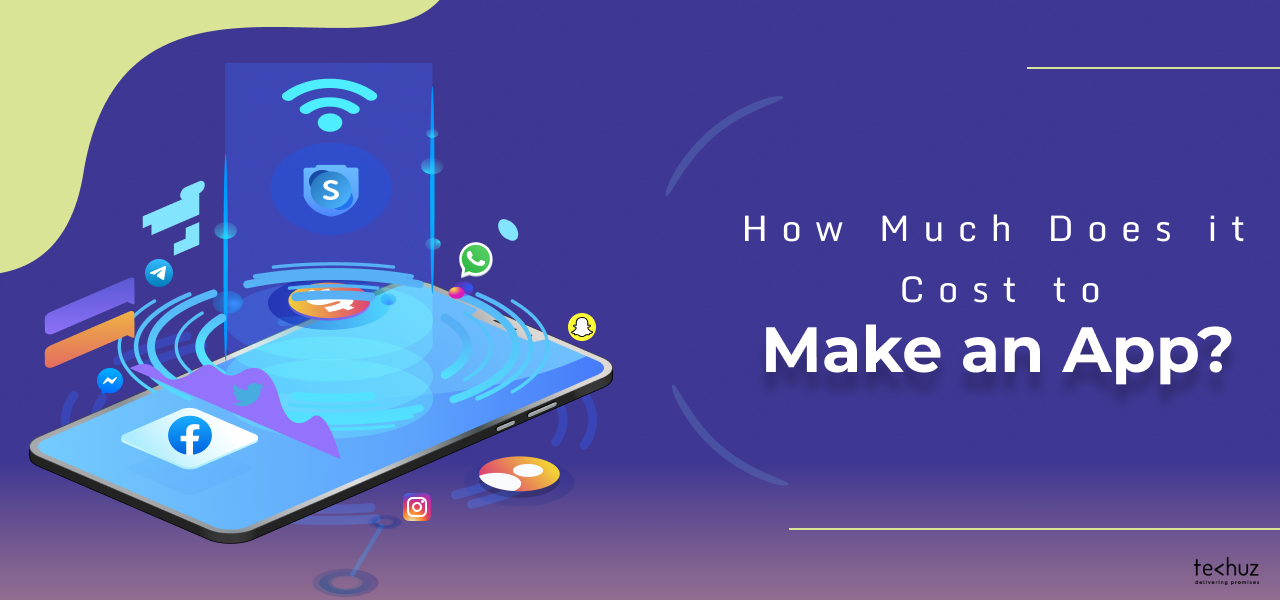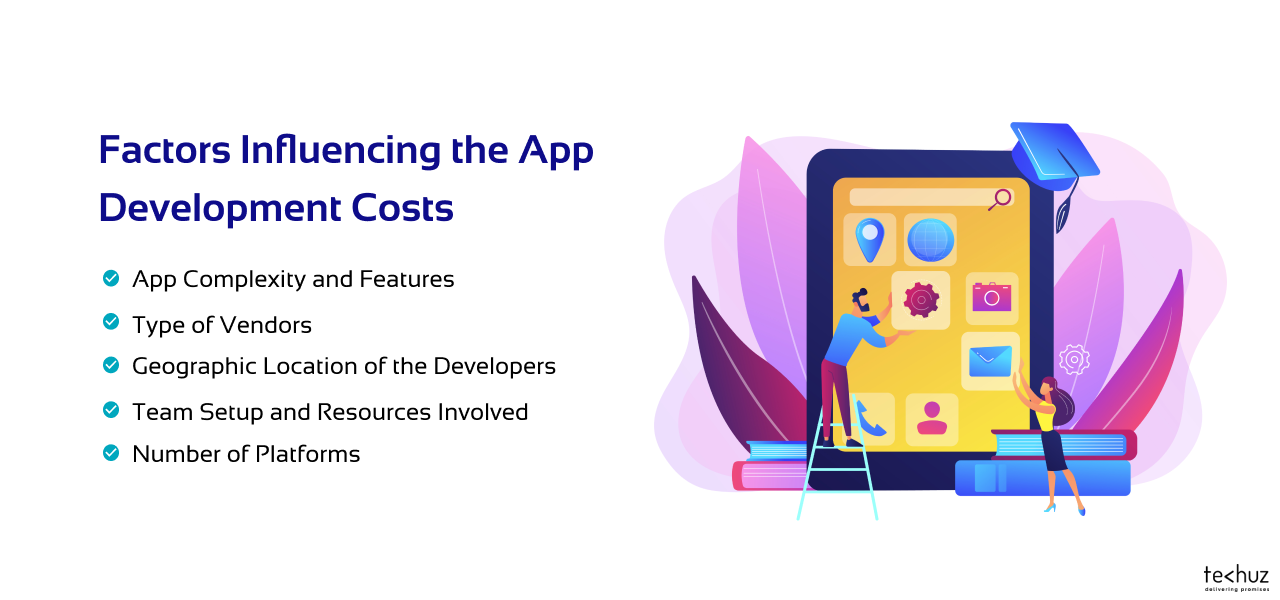Posted on
May 19, 2021
Updated on
March 21, 2024
Read time
 13 mins read
13 mins read
How much does it cost to make an app?
Well, as per a survey by Clutch, the cost of developing an app is between $37,913 and $171,450. That’s the median range, and the cost can even go beyond $500,000 depending on the design, features, complexity, rates of vendors, and myriad other factors.
Though that number is a good place to start, I’m sure you need a more accurate estimate to plan your budget. And more importantly, understand what exactly the cost constitutes. This blog will answer all your questions.
First, we’ll go through the average cost of developing different apps, then we’ll understand the factors that affect the price, and finally, some tips on how to reduce the cost of development and get the maximum bang for your bucks. Sounds like a plan? Let’s begin then.
How Much Does it Cost to Make an App?
One of the simplest ways to understand the cost of an app is based on its complexity. More complex the app, the higher the cost, and vice-versa. The following table shows the average estimated cost based on our data of developing 200+ apps.
| Type of App | Estimated Time | Estimated Cost |
|---|---|---|
| Basic | 3-6 months | $5000-20,000 |
| Average | 6-10 months | $25,000-50,000 |
| Complex | 10+ months | $50,000+ |
Sidenote: A complex app requires significant efforts to transform the business logic into an app. You may classify your app as complex if it requires…
- A number of complex features and advanced business logic
- Custom UI and UX design
- Developing complex architecture with multiple integrations and high-security needs
How Much Does it Cost to Make an Android/iOS App?
You may also what to consider the platforms for your mobile — either Android or iOS, or even both. Here’s how much it’ll cost to make a basic mobile app.
| Type of App | Estimated Time | Estimated Cost |
|---|---|---|
| Android | 3 months | $8000-12000 |
| iOS | 4 months | $10,000-15,000 |
Factors That Determine the App Development Costs
There’s a reason why the apps don’t come with a price tag. It’s because there are different factors that can influence the cost and without considering them, you can’t get an accurate quote. Here’s the list of the main factors.
- App Complexity and Features
- Type of vendor
- Geographic Location of the Developers
- Team Setup and Resources Involved
- Number of Platforms
1. App Complexity and Features
The number of features and the complexity to implement them are the primary deciding factors of the costs.
When you approach the developers, they’ll calculate the efforts in man-hours required to translate your business logic into a working app. The more complex your app requirement, the more man-hours it will take, and the higher will be the cost.
For instance, your app may have a pretty standard feature that’s usually implemented in every other app. So to implement it, either it can be developed with few efforts or if available, we can integrate a third-party API. But if the feature is unique, it will need significant time to research ways to implement it and develop a custom algorithm. All these results in more time and effort. The complexity of an app can be related to design, front-end, or backend development.
Design and Frontend Complexity
The user interface can be standard and template-based which requires fewer efforts. Or you may want custom designs based on research and data, and go through a proper UX design process — all that gives users a unique and pleasing experience. And then, implementing those designs into the frontend — the animations, transitions, and use of specific programming language.
Backend Complexity
The app backend may require complex logic to receive and respond to the user’s requests. For huge apps that serve millions of users and exchange huge amounts of data in real-time needs efforts to build an architecture that can handle it without breaking a sweat. Additionally, it may require using multiple programming languages as well as tools. Also, while third-party integrations may help boost the development speed and ease things, many niche integrations require extra efforts — including complicated documentations and complex development. And not to forget about the fees you pay to use these services.
Even the number of features you choose to include in your app will impact the costs. Initially while developing your app, when the budget is constrained or when you need to test your hypothesis, you can eliminate the good-to-have features and just add the basic necessary ones. There are many startups and minimum viable product examples that made it huge by initially launching the app with the basic necessary features and gradually scaling over time.
Here, check some of the standard features that apps commonly have along with development efforts in hours.
- User Registration/Login – Allows users to set up the account and password or register and log in via email, phone, or social media. The standard implementation of this feature requires around 20 -25 hours.
- Chat and Messaging – P2P chats that allow users to send text and other elements may take anywhere around 40-60 hours
- Search – Search functionality to find information in the app takes around 12 – 15 hours.
- Push notifications – The standard way of communicating with users on the device is the push notification. Implementing it may take around 8-10 hours
- Creating and editing user profile – Allows users to create the profile by adding personal information may take around 20-30 hours.
- Payment integration – Facilitating in-app payments via cards, e-wallets, and other payment services like Stripe, PayPal, Braintree, etc may take at least 40-60 hours.
- Admin panel – Admin panel with standard features such as viewing the user list, creating/editing/deleting users, checking the payment and related refunds may take around 100 -120 hours
- Geolocation – Geolocation is a pretty common feature in apps with location-based services such as Uber and Tinder. Implementing this feature may take approximately 40-60 hours.
- In-app purchases – Implementing app monetization through in-app purchases may take around 20-30 hours.
- In-app ads – Ad API integration that to monetize the app through ads may take around 16-24 hours
- Data encryption – End-to-end encryption of user’s data for protection against unauthorized access may take around 15-25 hours or more based on the type of data — text, image, audio, video.
2. Type of Developers – Freelancers vs Agency
You can hire a freelancer or an agency to develop your app. A freelancer is an individual developer who provides specific development services. While an agency consists of a team of developers all working and managed under a roof.
Hiring freelancers can be cheaper, but the low price comes with some drawbacks. One of the main drawbacks is the headache of finding different freelancers and managing them. You’ll need to find a designer, front-end and back-end developers, probably a QA engineer, and manage the project on your own. This can be a good option if you have previous experience as a project manager and some technical knowledge.
On the other hand, an agency might charge you a little higher than the freelancers but your app development is hassle-free and the results are guaranteed. The agency works in an organized way with all the expert resources you need in one place. If you are a non-technical person, this is the way to go. Apart from the designers you also get the team members such as business analysts and project managers that ensure a smooth development and desired end results. Here’s a quick comparison of agency and freelancer for app development.
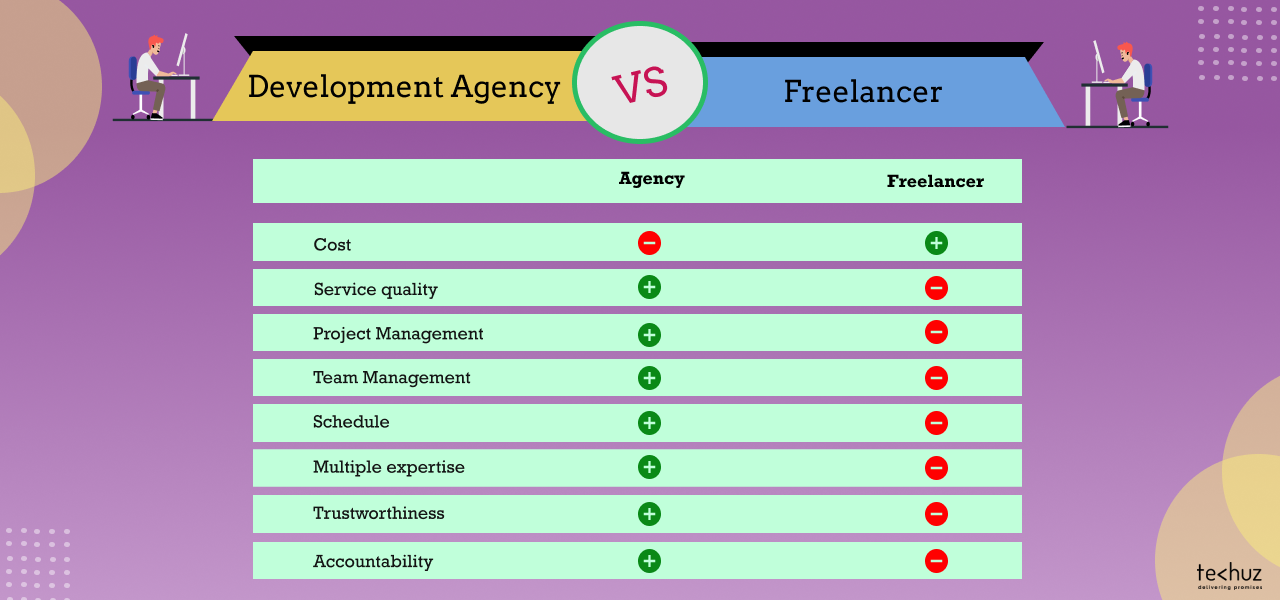
(Agency vs. Freelancer comparison)
3. Geographic Location of the Developers
The developer’s location is one of the major factors impacting the app cost. In fact, the difference can be as much as 50-100%. The reason? It’s because of the high disparity in development rates in different countries.
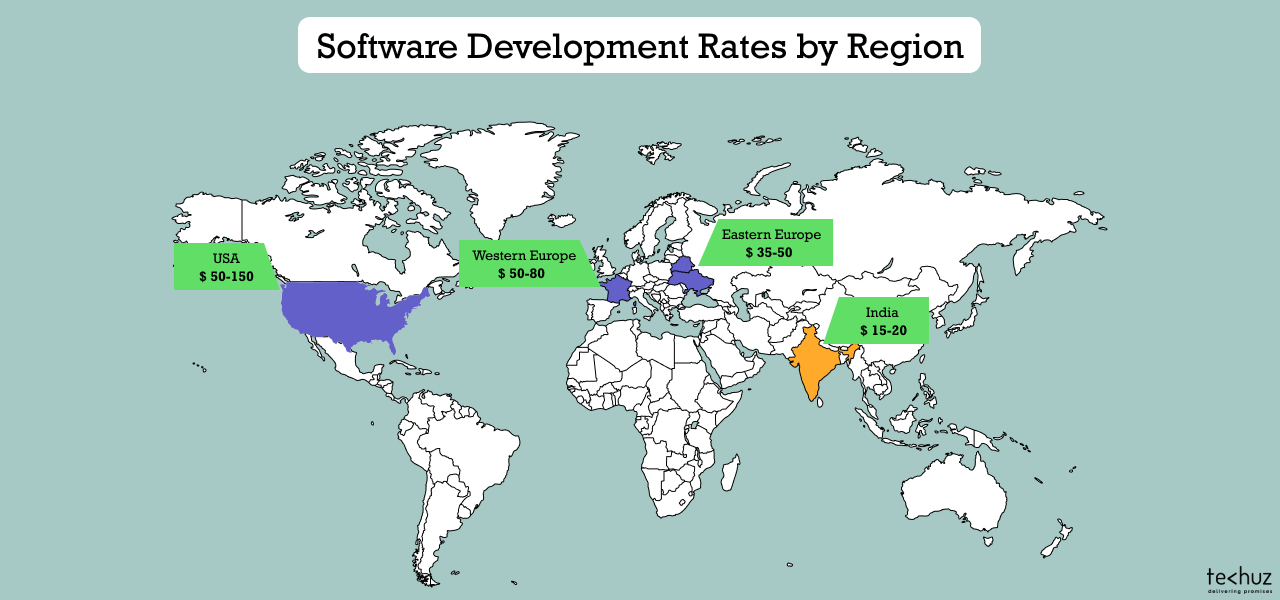
(Development rates in different countries)
And as a matter of fact, a high difference in price makes some counties ideal for outsourcing your app development. You can get great quality services at cost-effective prices. The popular app development locations include India, the US, and some parts of eastern Europe. Here are the existing development rates of resources in different countries.
| Developers | India | US | Eastern Europe |
|---|---|---|---|
| Developers | $15-25 | $50-150 | $35-50 |
| UI/UX Designers | $15-20 | $50-80 | 30-40 |
| Project Managers | $15-25 | $80-150 | $40-70 |
| QA Engineer | $15-20 | $30-60 | $50-120 |
| Business Analysts | $15-20 | $70-120 | $40-65 |
Now you know that there’s a significant variance in development rates. And the pricing in India might have struck your chords — but what about the quality?
Okay, so let’s address the elephant in the room — the misbelief that high rates mean high quality and vice versa.
The reality is that you can get the same quality services, or even better, at way cost-effective rates by outsourcing to India. You just need to hire the right development partner. I’ll suggest you read our guides on hiring developers and software outsourcing that’ll help you with it. Here’s a quick look at the hiring process:
- Do your homework
- Make a list of development companies
- Analyze the companies
- Select the ideal company
- Define the communication and project management process
- Provide regular feedback
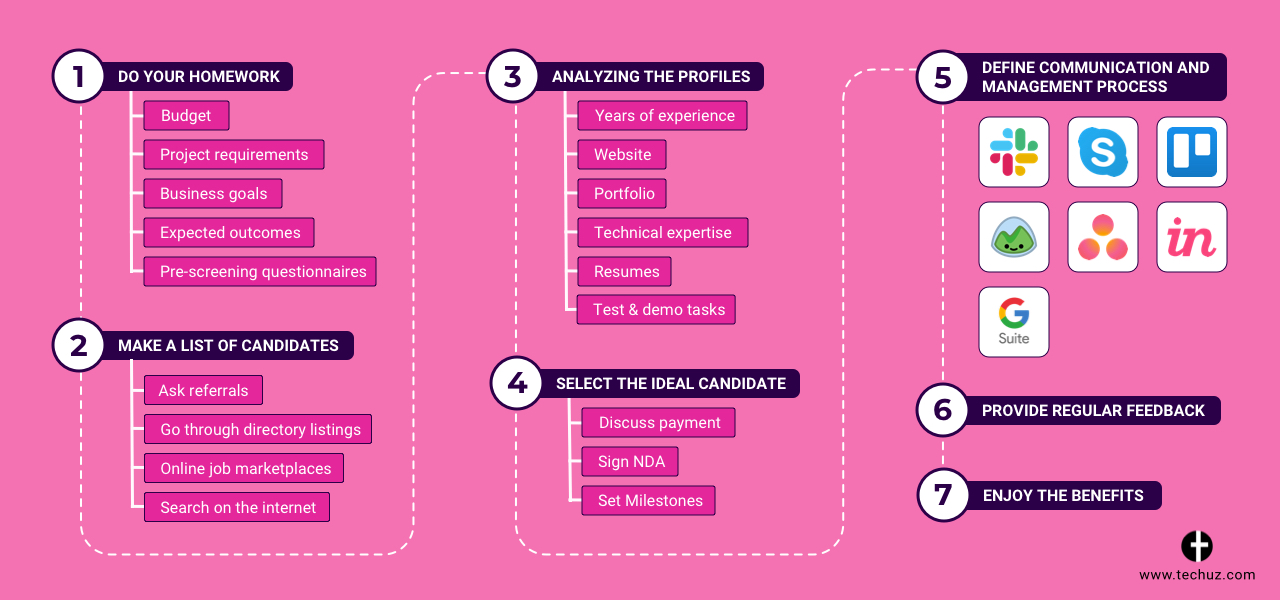
(App development team hiring process)
4. Team Setup and Resources Involved
The development team consists of members as per the project needs: business analysts, designers, developers, project managers, and QA engineers. You’re billed for each of these team members working on the project per hour. And these the number of resources, i.e. developers or designers are decided to complete the project in the estimated time frame. So the team setup and the number of resources involved impact the cost of making an app. On a standard project, you can expect 1 UI/UX designer, 1 back-end developer, 1 mobile app developer, 1 QA specialist, 1 project manager, and 1 business analyst.
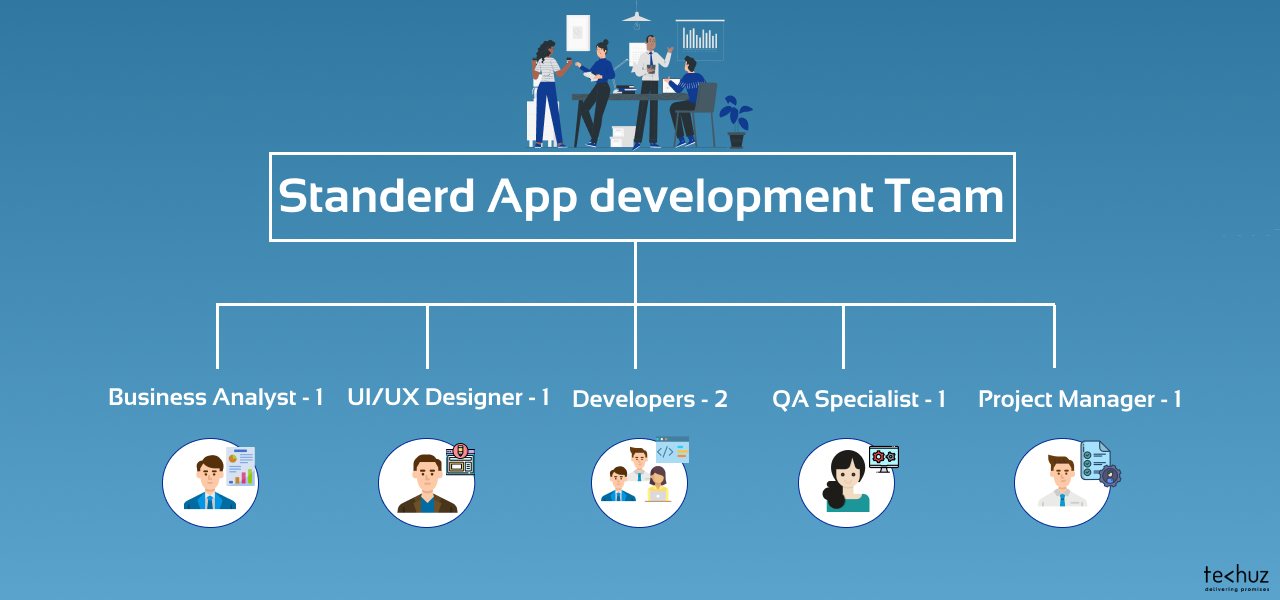
(The usual team members in an app development project)
However, the team members involved largely depend on the project needs and even the development method. For certain types of projects, you may need a specialized team member, for instance, a cloud architect. And if you want to follow a specific development methodology like Agile or Scrum you may need specialized members such as a Scrum Master for the project.
5. Number of Platforms
Another factor that affects the costs of the app is whether you choose to develop the app for one or multiple platforms. While deciding the platforms, you must research the market share of the platforms and OS used by your target audience. All the three platforms — iOS, Android, and the web will require separate efforts and team, tools, and SDKs. So whether you choose to develop the app for one or multiple platforms will result in a significant price discrepancy.
If you’re looking to develop the app for both the mobile platform, then you may consider developing a cross-platform app. Unlike native app development which requires separate teams and resources, cross-platform apps can be developed using React Native or Flutter and can be used on both the platform.
Tips To Reduce the App Development Cost
Now you know how much does it cost to make an app and what factors affect the cost. But we have something more for you. We know app development is a huge investment and anything that could reduce the costs or at least give maximum bang for bucks will be helpful. So here’re are a few tips that can come in handy while developing your app.
Prioritize Features
It’s essential to understand the must-have and nice-to-have features of the app. When budget is constrained, it’s better to prioritize and develop the features based on the value it creates to the users. In the initial launch prioritize the development of core features while keeping the nice-to-have ones for the later versions. This is often used in developing minimum viable products to gauge the market reactions and gather feedback for later development, and at the same time keeping the cost to the minimum.
Outsource to the Right Development Team
Outsourcing significantly reduces the costs and overhead expenses. You don’t have to bother about recruitment, salaries, employee perks, hardware, and workspace. All you need to do is find the right development team and enjoy high-quality and cost-effective services. Ensure you’re hiring the right team by doing your research, interviewing the developers, understanding the agency’s expertise, and reviewing their past work.
Select the appropriate Pricing model
There are two popular pricing models when it comes to app development. Each comes with some pros and cons, but selecting the right one as per the project needs will eliminate any squander.
Fixed-price: Fixed price works simple — decide the scope of the work, agree on a price, and the vendor delivers it in the given time frame. This goes well with small projects that have pretty straight and clearly requirements. The drawback of this model is its rigidity. As the tasks and price are fixed in advance, changing anything later is difficult and adds more cost to the initial quote.
Time & Material: This is the most relevant pricing model for app development. You pay for the time, i.e. number of hours spent on the tasks and material, i.e. team members involved in the task. This model is super flexible as you can add, remove or change the tasks at any stage. Time & material model is pretty ideal for huge projects with frequent changes and iteration.
So choose the appropriate pricing model for max benefits. Also, it is advisable to make the payment based on the milestone that works great for both you and the vendor. Generally, the vendors start the project with a part lumpsum amount, and then you’re billed on completion of pre-decided milestones.
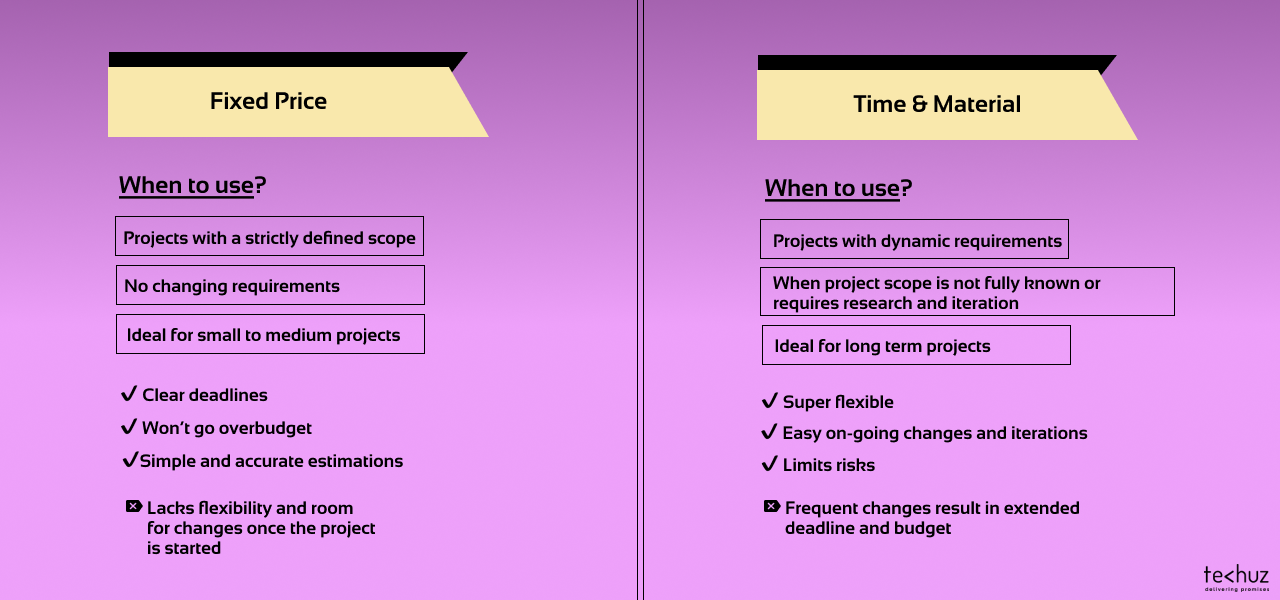
(Fixed Price vs. Time and Material models comparison.)
Testing and Feedback
Ensure your app is tested early and tested frequently. Resolving the red flags early on at each stage of development reduces the risk of any serious issues and rework in the final product. Also, define a communication and feedback process to ensures the app is developed the way you want.
Keep Scalability in Mind
While it’s essential to prioritize the features to eliminate unnecessary ones, it is equally important to plan the scalability in advance. As your app grows it will need to fulfill more requests and even add new features. Ensuring the architecture is easily scalable and without much rework will help you reduce future costs.
Wrapping Up
Hope this article has helped you understand the app development costs and factors that affect the final price. And if you consider the factors and follow the above tips, you’ll surely be able to lower the app development costs for world-class app development.
And in case you’re looking to hire a development team and need an accurate quote of what’s, it’s going to cost you, feel free to drop us a line.
Here’s what happens once you place an inquiry.
- Our sales team will connect with you within 24-48 hours to understand your project requirements.
- Based on the information you provide, our business analyst with the technical team will prepare a ballpark quote.
- After that, we create a detailed project statement of work (SoW) with exact deliverables, their timeline, and development activities.
- And if you find it optimum we can proceed to build your app.
